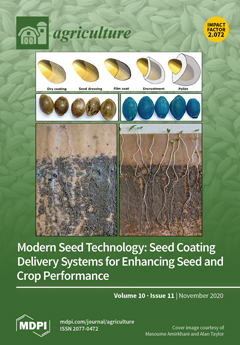Bacterial leaf blight (BLB), a vascular disease caused by
Xanthomonasoryzae pv.
oryzae (
Xoo), induces a significant reduction in rice yield in severe epidemics. This study investigated the transcriptional regulation of the
OsDHODH1 gene in rice cultivars exposed to the
Xoo
[...] Read more.
Bacterial leaf blight (BLB), a vascular disease caused by
Xanthomonasoryzae pv.
oryzae (
Xoo), induces a significant reduction in rice yield in severe epidemics. This study investigated the transcriptional regulation of the
OsDHODH1 gene in rice cultivars exposed to the
Xoo K3 isolate. The symptoms were monitored on a daily basis, and the lesion length of inoculated rice plants was scored 21 days post inoculation (dpi). The most resistant and the highly susceptible cultivars were used for gene expression analysis. The dihydroorotate dehydrogenase (DHODH) domain is shared by many proteins in different plant species, and in
Arabidopsis, this protein is encoded by the
AtPYD1 gene. To investigate the functional role of the
OsDHODH1 gene under bacterial infection, we inoculated the
Arabidopsispyd1-2 knockout (
atpyd1-2) plants, lacking the
AtPYD1 gene (orthologous gene of the rice
OsDHODH1), with
Pseudomonassyringae pv.
tomato (
Pst) DC3000
vir, and the phenotypic response was scored 9 dpi. Results show that
OsDHODH1 was upregulated in Tunnae, the most resistant rice cultivar but downregulated in IRAT112, the highly susceptible rice cultivar. In addition, Tunnae, Sipi and NERICA-L14 exhibited a durable resistance phenotype towards
Xoo K3 isolate 21 dpi. Moreover, the expression of
OsPR1a and
OsPR10b (the rice pathogenesis inducible genes) was significantly upregulated in Tunnae, while being suppressed in IRAT112. Furthermore, the
atpyd1-2 plants exhibited a high susceptibility towards
Pst DC3000
vir.
AtPR1 and
AtPR2 (the
Arabidopsis pathogenesis inducible genes) transcripts decreased in the
atpyd1-2 plants compared to Col-0 (wild type) plants. Due to the above,
OsDHODH1 and
AtPYD1 are suggested to be involved in the basal adaptive response mechanisms towards bacterial pathogen resistance in plants.
Full article





